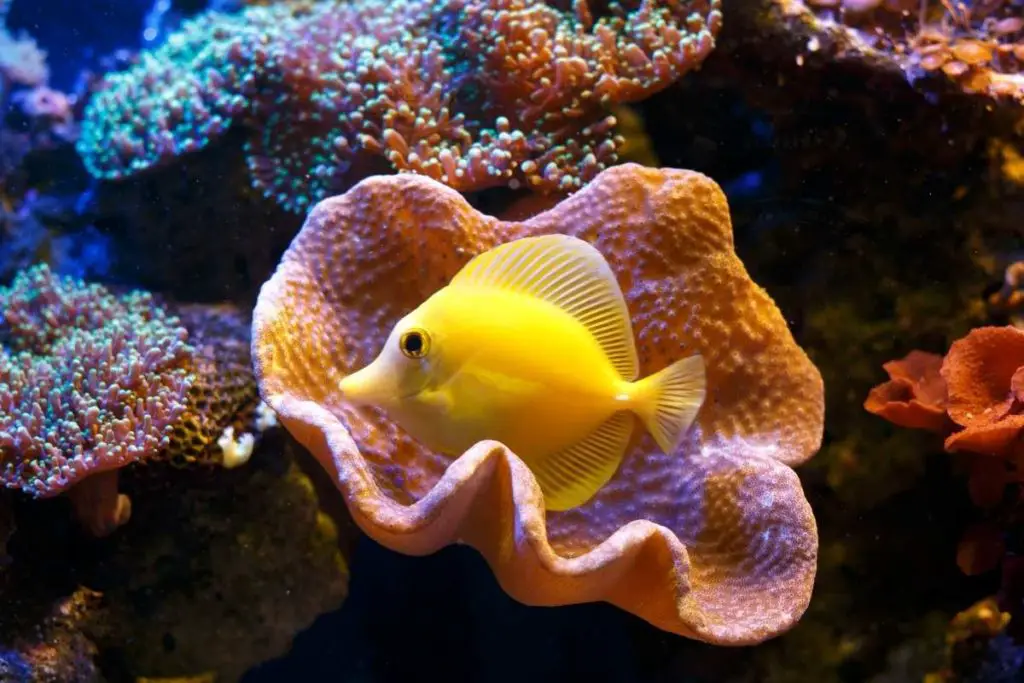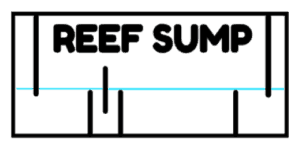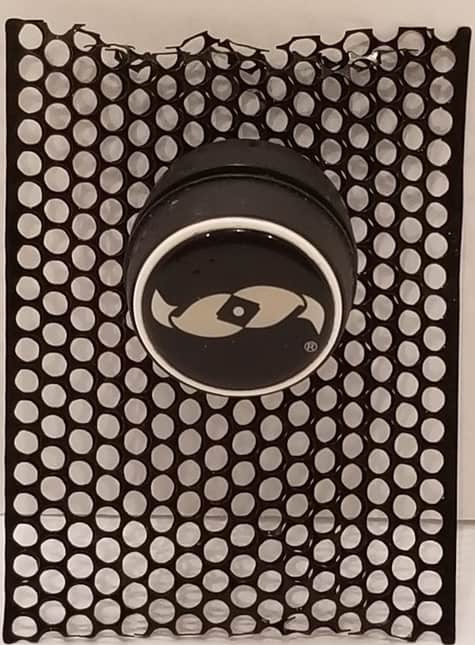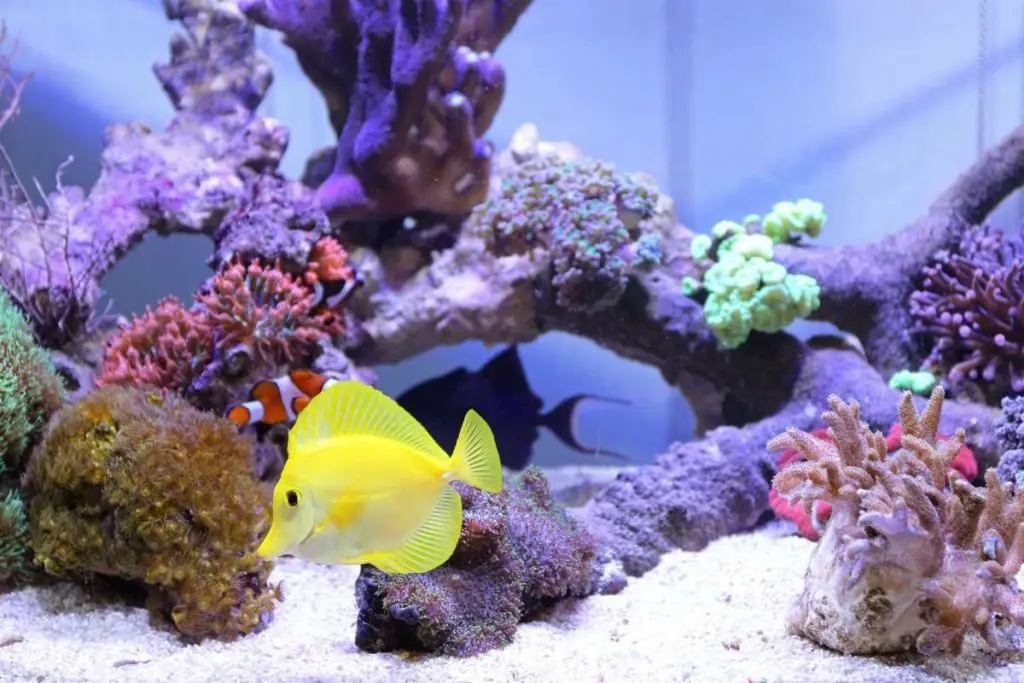
In my many years of reef tank keeping, I’ve always had Tangs as a part of my community reef tanks. I’ve kept many different kinds of Tangs including Blue Hippo, Yellow, Purple, and various bristle tooth tangs. Tangs are my absolute favorite type of fish for my display tanks and I’ve spent a lot of time observing their behavior in reef tanks. Tangs are reef safe spending most of their time searching out algae as their primary food source leaving corals of all types alone. Not only are Tangs reef safe, but they also may be one of the best selections for a peaceful reef community tank. Tangs come in different shapes, sizes, colors, and temperaments. This article will outline many considerations to think about when adding and keeping a Tang in your reef tank.
What is a Tang fish?
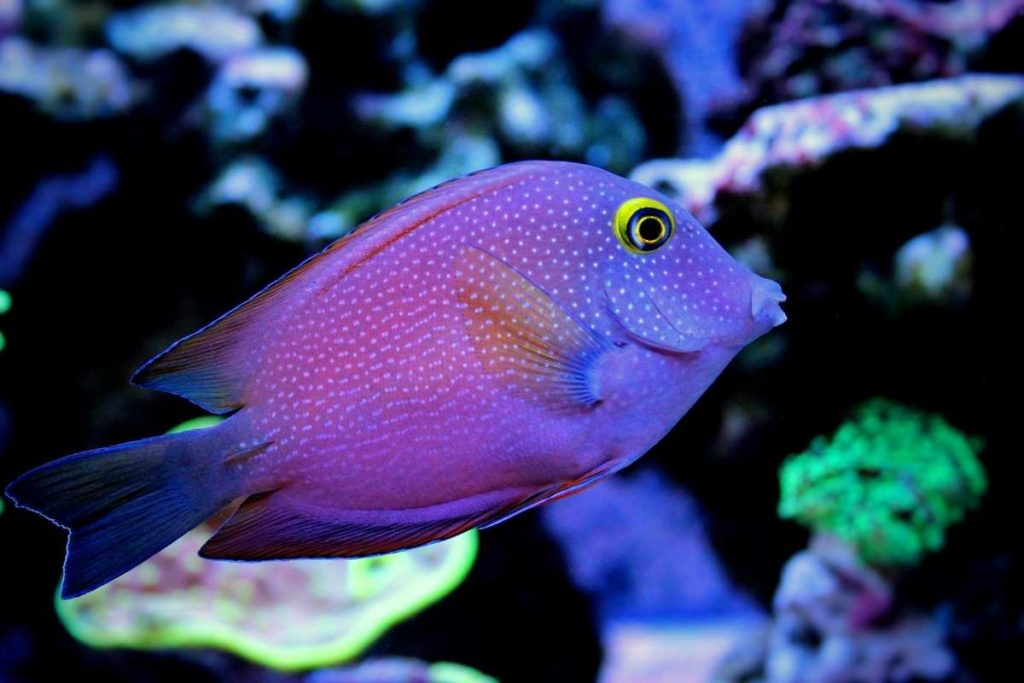
Tangs are often also called Surgeon or Doctor fish. They get their name from a sharp scalpel-like spine scale usually present on both sides near their tail. This scalpel can be very sharp and injure a person if the fish is large and mishandled. Though Tangs have this defensive mechanism, I’ve never had one attempt to use it on my arm or hand while it is in the tank. I have often seen Tangs posture with other tangs, but have not seen a Tang injure another tang in any of my tanks.
Tangs are herbivores that are constantly grazing and on the hunt for various forms of algae in a reef tank. Tangs will eat many forms of nuisance algae in a reef tank including the dreaded hair algae. I find that tangs are greedy eaters and will eat just about any prepared foods that go into the tank including meaty foods like Mysis shrimp. A Tang’s ability to search and destroy algae in a reef tank makes them a near-perfect fish for reef tanks as they play a role in the clean-up crew and make for a vibrant display fish. Tangs typically have lots of personality in the reef tank spending their day out and about swimming and grazing from side to side of the reef tank. The Tangs I’ve owned typically have a peaceful yet bold demeanor. I prefer peaceful community tanks and it is usually the tang that is the biggest fish in the tanks I keep. I find that Tangs will occasionally put other fish in their place with a brief chase, but overall leave other fish alone rather than constant harassment that you see in other aggressive fish. Aggression could be an issue with multiple tangs. If space or food is scarce you may find aggression between tangs in the same tank.
What type of tangs are there?
There are 5 different types of tangs Acanthurus, Bristletooth, Unicorn, Zebrasoma or Sailfin, and Paracanthurus.
- Acanthurus Tangs: Some of the most popular Acanthurus tangs include Achilles, Powder Blue, Clown, Sohal, Chocolate, and Convict Tangs. Some of the Acanthurus tangs such as the Achilles and Powder Blue are very difficult to keep in a reef tank as they are very prone to disease. Acanthurus tangs typically need more room and ideal water parameters and conditions to keep them healthy.
- Bristletooth Tangs: As the name suggests, Bristletooth Tangs have special teeth that allow them to aggressively graze algae off of live rock in the reef tank. Some popular Bristletooth Tangs include Chevron, Kole, and Tomini Tang.
- Unicorn Tangs: Unicorn tangs are among the largest of the tangs you will often see in reef tanks. Due to their size, a very large tank is necessary for most Unicorn tangs. Some popular Unicorn Tangs include Blonde Naso, Naso, and Vlamingii Tangs.
- Sailfin Tangs: Sailfin Tangs are among the most popular and beautiful Tangs in the reef tank hobby. Sailfin tangs make great reef tank pets as they are generally peaceful, brightly colored, and relatively easy to care for. Sailfin-type tangs include Yellow, Purple, Sailfin, and Gem Tangs.
- Paracanthurus Tang: There is only one Tang in this type, the Blue Hippo Tang. Everybody knows this Tang from the Nemo movies as Dorry. Blue Hippo Tangs are wonderful fish but quite delicate and can be hard to care for when not in an appropriate reef tank. Blue Hippos get large and large rather quickly. To prevent stress to the fish they should be kept in a large aquarium with appropriate horizontal swimming space and places for them to hide.
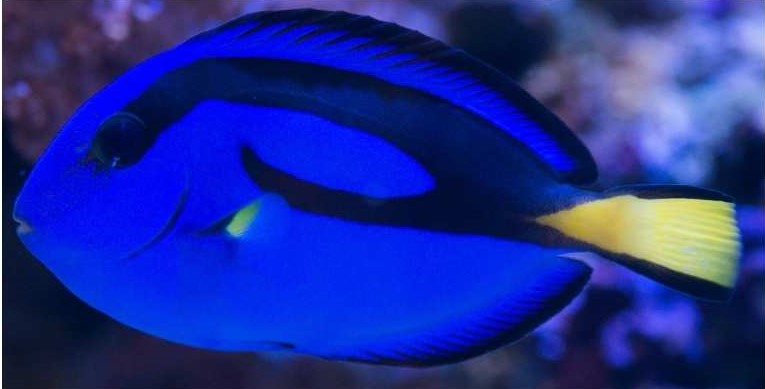
What are the best tangs for a reef tank?
The best tangs for reef tanks are the Zebrasoma and Bristletooth tang types. Zebrasoma tangs are great for reef tanks because they are widely available, vibrant looking, and relatively peaceful, and easy to care for. Zebrasoma tangs are full of personality and spend their day front and center grazing throughout the tank. Bristletooth tangs also make great additions to the reef tank as they are generally smaller and less active in the reef tank making tank size requirement less than other tangs. Their specialized teeth make them an excellent members of the clean-up crew.
I don’t recommend trying to keep Unicorn, Blue Hippo, and most Acanthurus tangs unless you are prepared to provide a large tank, ideal water parameters, and tight consistency with their care.
What size reef tank do you need to keep a Tang?
The minimum size tank that I would recommend for keeping a tang is 40 gallons. You might get away keeping a small Bristletooth Tang in a 30-gallon tank, but the larger the better for most tangs. Another factor to consider is the horizontal swimming space available for your Tang. In the wild tangs swim miles upon miles in the open unobstructed ocean. You’ll want to provide as much open vertical swimming space for your Tang as possible. Make sure that any branching coral and live rock don’t impede into vertical swimming space for your fish. I like to keep Tangs in my reef tanks and to do so I have most of my live rock and coral stacked in the back of the tank with an open sand bed in the front and at least 50% of the front half of the tank open for vertical fish swimming. I also make sure to create caves in the rock work for the fish to hide and sleep in. This is especially important when keeping a Blue Hippo Tang. I find that Tangs also like a good amount of flow. I’ve often observed my Tangs swim against the flow of a powerhead throughout the day almost as if exercising on a treadmill.
Can you have multiple tangs in a single reef tank?
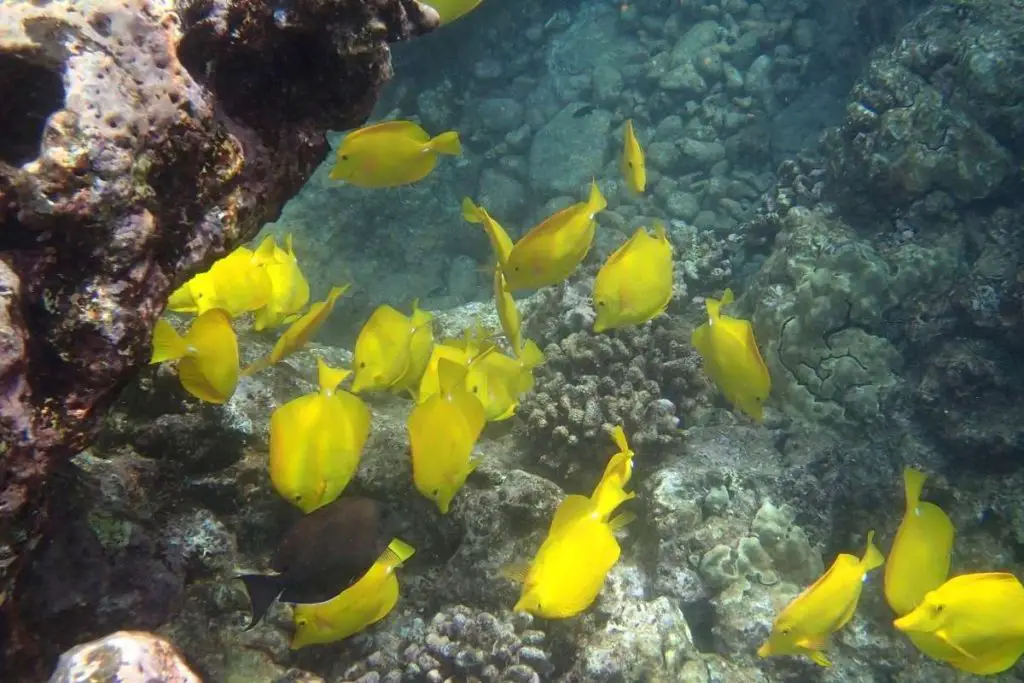
Under the right conditions, it is possible to multiple tanks in a single tank. Tangs can be territorial when it comes to space and the same or similar species. To successfully keep multiple tangs the first consideration needs to be tank size. For my tanks, I consider gallons and horizontal swimming space when considering multiple tangs. I like to use 24″ of horizontal swimming space per tang. For gallons, I’ll usually consider 40-50 gallons per tang. Here are a couple of examples of my current tanks where I feel my tangs are happy and healthy:
- 210 gallon 6-foot tank: Purple Tang, Blue Hippo Tang, Tomini Tang
- 75 gallon 4-foot tank: 1 Yellow Tang
Another consideration to increase your probability of success with multiple tangs is species selection of your Tangs. Tangs may get more aggressive or territorial with the same or similar shape/size tangs. A best practice is to choose different types of tangs like 1 Zebrasoma and 1 Bristletooth Tang instead of 2 Zebrasomas or 2 Bristletooth Tangs. If possible you’ll want to introduce the largest Tang to display tank last to help with the establishment of territory.
Are Tangs always reef safe?
In all the years and different types of Tangs that I’ve had, I’ve never seen any of my Tangs aggressively go after coral in my tank. I’ve had acros, soft corals, euphyllia, zoas, and just about everything else in between without my Tangs bothering them. I find that tangs primarily will pick around the coral for algae which helps the corals and keeps the tank looking nice.
While reef safe generally means the fish won’t eat coral, I have had some issues with Tangs rearranging their living space. I have a large very active Blue Hippo Tang that absolutely hates it when I add frags to the tank. If I add coral to my tank without securing it down my Blue Hippo will either knock it down swimming by it or will sometimes even pick it up with its mouth and move it. I’ve found the easily remedied by fully securing frags down with epoxy and super glue.
I have heard stories of rogue Tangs that can get overly aggressive with grazing and destroying coral, but I have not experienced that myself. The probability of this may increase as the fish gets larger.
What are some of the drawbacks to keeping a Tang?
The biggest drawback of having Tangs is that they can very susceptible to parasites and illness. Tangs have very small scales and a limited protective slime coat making them targets for Ich and Marine Velvet. When bringing home tangs it is imperative to do a full quarantine before adding them to the tank. Keeping the fish stress-free via proper feeding, tank size, and setup will give you many enjoyable years with your tang. In terms of feeding, the best thing you can do for your Tangs is feeding them algae.
How to set up a quarantine or hospital tank for your reef tank
What types of algae to feed to Tangs and how to feed them?
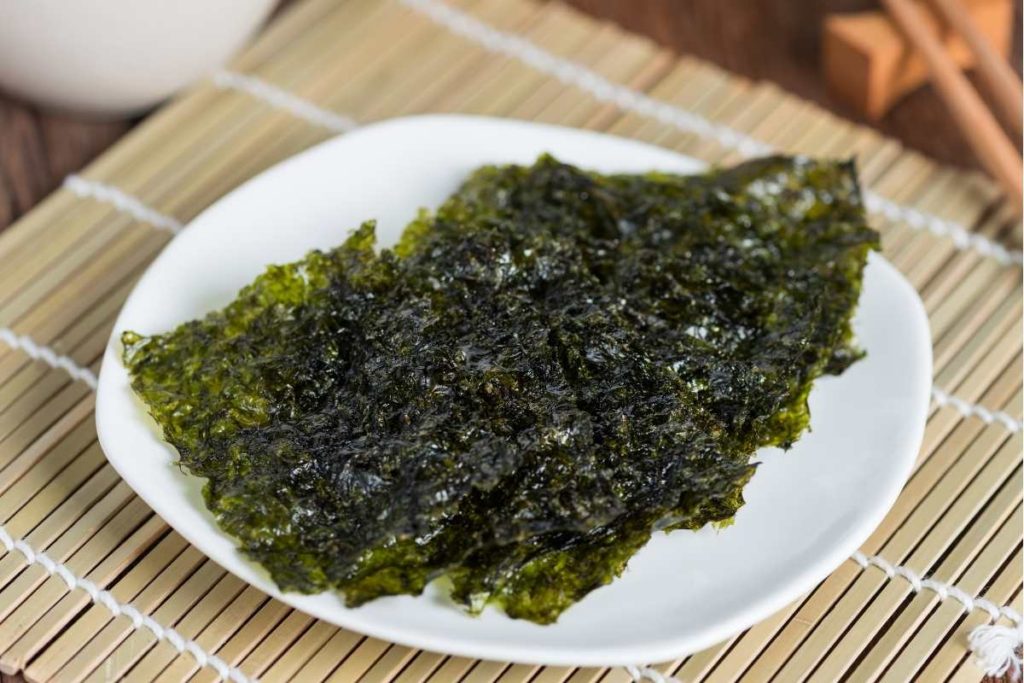
Tangs will naturally eat various types of unsightly algae in reef tanks primarily hair algae. From what I’ve seen in my tanks, my tangs prefer young new growth algae and sometimes will not touch hair algae if it is large and at infestation levels. I wouldn’t expect a tang to clean up a heavily infested hair algae tank. In addition to what the Tangs consume naturally in the tank, I supplement using a variety of prepared and grown algae including pellets, flakes, macroalgae, and best of all Nori.
How to feed Macro Algae to Tangs
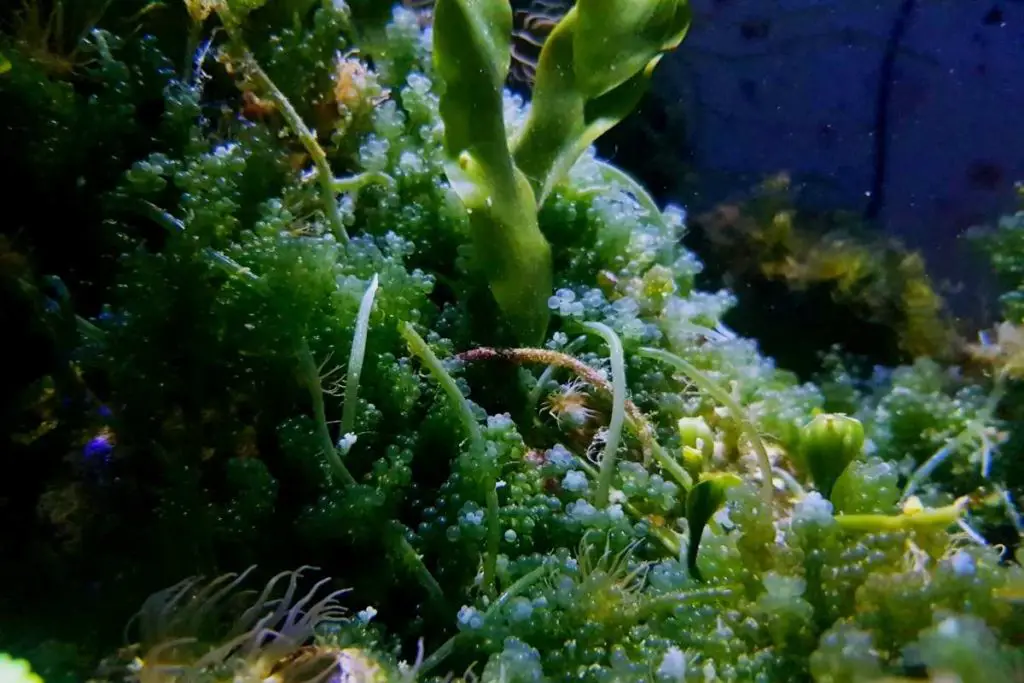
If you have a refugium, it’s an amazing thing to grow macroalgae in it that tangs will eat. I’ve grown red ogo and sea lettuce in the refugium and my tangs gobble it up. I like to take a small piece of live rock and secure the algae down with a rubber band to give a nice natural feeding to my tangs when feeding live-grown macroalgae. Another option is Caulerpa algae. I don’t like this option as there are few drawbacks to using Caulerpra with the primary being it can be invasive and hard to remove if it gets loose and starts growing in the display tank.
How to feed algae pellets, flakes, and waffers to Tangs
I like to feed my reef tank a combination of frozen, flake, and pellets. I feed two small portions throughout the day and rotate the type daily. There are many types of algae-based foods on the market and the two that I traditionally use for my tangs are Hikari Marine Herbivore pellets and Ocean nutrition Formula Two flakes. My Tangs love both these foods and all the other fish in the tank eat them too. I feed just enough so that the entirety is consumed within 15-25 seconds or so.
How to feed Nori to Tangs
Nori is probably the best and most natural algae food you can regularly feed your tangs. Nori is dried seaweed that comes in paper-like sheets and is used mainly for the preparation of sushi. Nori can be easily found at most grocery stores. When buying nori from a grocery store for your fish make sure to buy plain Nori that does not include additional items like seasoning, oils, or salt. I also like to buy organic when available. There are many options available made by reputable companies for reef tanks. Here are a couple of option on Amazon that I’ve used with good success:
Two Little Fishies Sea Veg-Green Seaweed
Super nutritious Natural Green Seaweed sheets. Ideal for marine herbivores such as Tangs and Surgeonfish, Moorish Idols, Parrotfish, Angelfish, large Butterflyfish and herbivorous freshwater fishes, such as Cichlids and Goldfish.
Omega One Super Veggie Green Seaweed
Made with the finest seaweed available, an excellent veggie treat for omnivores! The re-sealable bag keeps the seaweed fresh and pre-cut pieces are easy to use and eliminate waste.
There are many methods to feeding nori to your fish. The first is to simply cut into small pieces and add to the tank similar to flake food. At my local fish store, they have a tank with large angelfish and tangs and the owner simply takes a half sheet of nori a day and drops it into the tank. The fish are so large and aggressive with eating the nori that they tear it apart in seconds. In the wild Tangs spend a significant time grazing for algae and like to try and mimic this in my reef tank by feed nori when they can consume it over a greater amount of time. One method is to use the rubber band and live rock as outlined above. Another option is to use a seaweed clip. For these, you clip on a piece of seaweed, and a suction cup holds it to the glass on the inside of the tank.
My current favorite way to feed my Tangs nori is using the Two Little Fishies Pouch Feeder. This feeder uses a plastic mesh with magnets to hold nori against the glass inside the tank. The small holes allow for slower grazing when the nori is introduced to the tank.
Tangs are about the perfect reef-safe fish and with proper care and environment will thrive in your reef tank for many enjoyable years, happy reefing!
